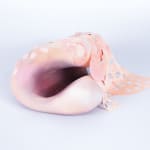Kate Casanova
Spotted Flush, 2022
Polymer modified gypsum, hand-dyed fabric, paper clay, glass beads, acrylic paint
6 x 9 x 17 in
15.2 x 22.9 x 43.2 cm
15.2 x 22.9 x 43.2 cm
KC0011
Casanova leans (sometimes literally) into what something can be, rather than what it simply is. Spotted Flush chronicles the moment her forearm pushes down and creates an indent into the...
Casanova leans (sometimes literally) into what something can be, rather than what it simply is. Spotted Flush chronicles the moment her forearm pushes down and creates an indent into the gypsum. As the material hugs and surrounds her forearm, the impression creates a cavernous crevice that marks the meeting of the artist’s physical body with raw material. Casanova then paints the cavity a purplish, speckled hue to distinguish this section from the outer, fleshy form, drawing the viewer in to further inspect and explore every nook and cranny.
Kate Casanova’s latest collection of hyper-tactile sculptures seep and ooze a foreign, yet strangely familiar, sensibility at every crevice, coil and pore. The artist’s practice is entrenched in exploring the depths of what a human and non-human body can be. Her works are pluralistic and in process, shapeshifting into new forms that defy categorization and refuse to be fixed or defined. The work continues Casanova’s exploration of abstract, biomorphic forms that challenge binaries and notions of hybridity. Her large and small-scale sculptures embrace the boundlessness of being just one thing, toeing the line between human/non-human, hard/soft and organic/synthetic.
Growing up in northern Minnesota near the Canadian border, Casanova developed a deep connection to nature and the natural world. Time outside was a precious opportunity to observe her non-human neighbors or “companion species” as the artist fondly refers to them. Her experiences engaging with the complexities of the natural world began to inform her visual language and shape questions about form and the in-betweenness of bodily knowledge. Casanova applied this pursuit of feeding curiosity and discovery in her approach to exploring materiality of the post-human. This term is used across multiple fields of study and is of particular interest to Casanova, as it relates to the non-hierarchical ordering of species.
Kate Casanova’s latest collection of hyper-tactile sculptures seep and ooze a foreign, yet strangely familiar, sensibility at every crevice, coil and pore. The artist’s practice is entrenched in exploring the depths of what a human and non-human body can be. Her works are pluralistic and in process, shapeshifting into new forms that defy categorization and refuse to be fixed or defined. The work continues Casanova’s exploration of abstract, biomorphic forms that challenge binaries and notions of hybridity. Her large and small-scale sculptures embrace the boundlessness of being just one thing, toeing the line between human/non-human, hard/soft and organic/synthetic.
Growing up in northern Minnesota near the Canadian border, Casanova developed a deep connection to nature and the natural world. Time outside was a precious opportunity to observe her non-human neighbors or “companion species” as the artist fondly refers to them. Her experiences engaging with the complexities of the natural world began to inform her visual language and shape questions about form and the in-betweenness of bodily knowledge. Casanova applied this pursuit of feeding curiosity and discovery in her approach to exploring materiality of the post-human. This term is used across multiple fields of study and is of particular interest to Casanova, as it relates to the non-hierarchical ordering of species.




